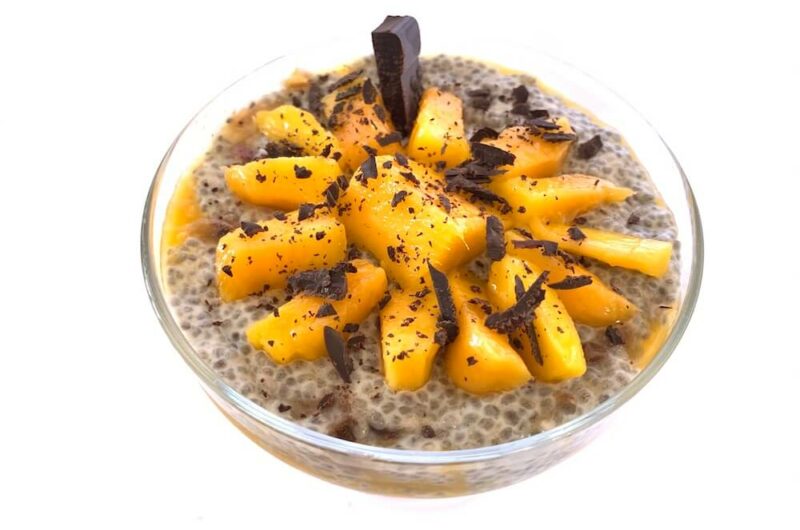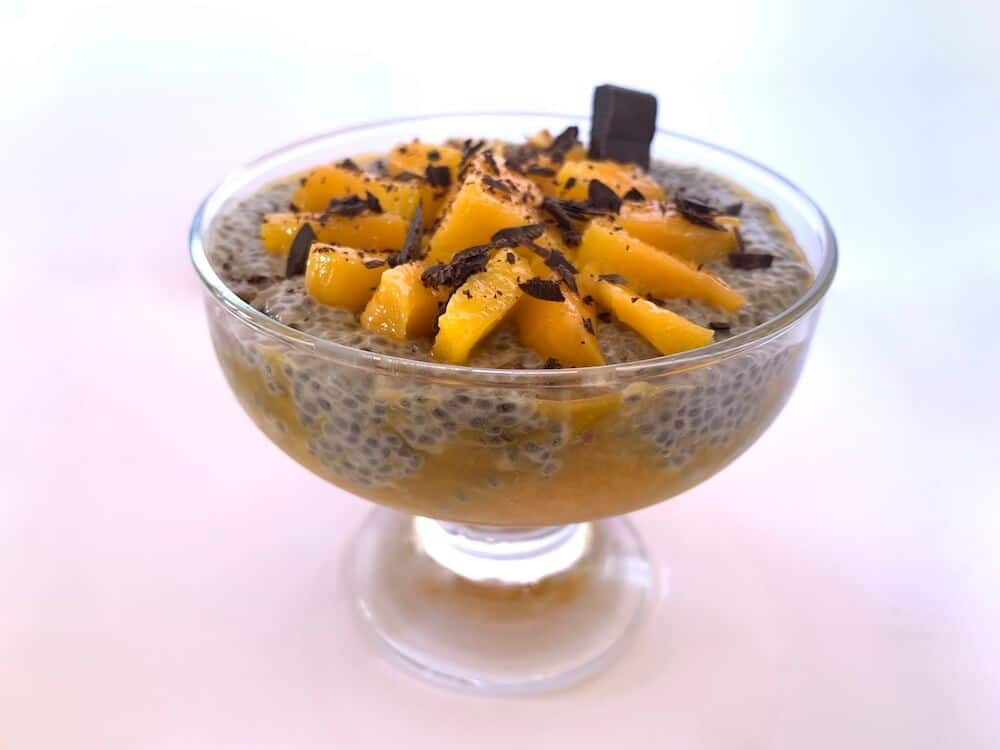I’m so excited to share my favourite chia seed pudding with mango with you.
It’s not only oh-so-simple, and oh-so-delicious but also supremely nutritious!
I must admit that since first publishing this post I created an exceptional strawberry chia pudding and it’s taken the king spot as my favourite dessert ever.
And if you’re looking for a different kind of dessert, you might like these raw vegan cheesecakes or the most decadent but surprisingly healthy, oil free chocolate brownies.
But back to the mango version, which is also delicious by the way!
Not only is this a healthy dessert delicious with a mere 6 ingredients, but it’s also jam packed with health-promoting plant protein, antioxidants, omega 3, iron, calcium & fibre from the chia seeds.
And in case you didn’t know it already, protein helps to build muscle and lose weight. As well as that, this is a great source of antioxidants to combat those free radicals.

Table of Contents
Free Radicals Vs Antioxidants
Free radicals are naturally present in the body as a waste product from chemical activity, and they are an important part of the immune system, travelling through the blood system attacking foreign invaders.
However, too many antioxidants lead to oxidative stress: electrons like to be in pairs, yet a free radical is alone, so it scavenges for another electron (to pair up with) from other molecules, thus de-stabilising the molecule, robbing it of its electron and converting that molecule into a free radical.
The new free radical then repeats the process creating a chain effect throughout the molecules.
When free radicals de-stabilise other molecules and cause body damage, they play a role in leading to diseases such as Alzheimer’s, Parkinson’s, cancer, macular degeneration, cardiovascular disease, arthritis, inflammatory diseases and signs of ageing.
Antioxidants, however, can provide an electron for the free radical without becoming unstable themselves. Their job is to clear up the scavenging free radicals from the system.
They can be eaten in fresh foods such as chia and fresh fruit and vegetables and although supplements exist, it hasn’t been proven that the supplement works as well as eating the antioxidant in food.
So what are you waiting for? Let’s make sure we get enough antioxidants in our diet!
What Are Chia Seeds?
Chia or Salvia Hispanica, is an annual herbaceous plant which is native to Mexico and Guatamela and is a member of the mint family.
The seeds have been eaten for thousands of years in Central America, but it’s only in more recent times that they’ve become recognised and popular as a super food in the rest of the world.
These days chia is also cultivated in Bolivia, Ecuador, Nicaragua, Argentina, Australia, and the United States, and in some locations such as the UK with colder climates, it’s grown in greenhouses.
The plant cannot tolerate frost, and grows only land above 200m, on plains, in desserts and in mountainous regions.
Chia grows up to 1 metre in height and has blue or white flowers. The name ‘chia’ is the Spanish adaptation that comes from the word ‘chian’ or ‘chien’, which means oily in Nahuati (a language of the Aztecs).
After flowering, chia forms round fruits full of tiny chia seeds which can be white, grey, brown or black in colour.
Nutritional Content Of Chia Seeds
Chia is rich in dietary fibre, providing a higher % than cereals, dried fruit, flax & nuts. Chia is an excellent source of omega 3, with even higher levels than flax.
But omg, I also love flax!
I eat flax and chia because I love them both in different ways. You can read about the benefits of flax seed here.
18 – 24% of the chia seed is plant protein with all 9 essential amino acids. The seeds supply many minerals including phosphorus, calcium, potassium and magnesium.
The highest vitamin presence is vitamin B1 (thiamine), B2 and B3 (niacin). Chia seeds are also a rich source of phytocompounds and tocopherols (vitamin E).
They are one of the most healthy, nutrient-packed foods in the world, and provide protein, fibre, omega 3, vitamins, minerals and antioxidants.
Health Benefits of Eating Chia Seeds
Chia seeds are considered extremely healthy to include in your diet, and are full of protein, fibre, vitamins, minerals and antioxidants.
They’ve been eaten for thousands of years, dating back to the Aztecs and Mayans, and have also been used for medicinal purposes throughout history.
The protein in chia seeds is high quality, containing all 9 of the essential amino acids, and is therefore a complete plant protein source.
Eating enough protein in your diet is essential to maintaining health and will help to build lean muscle as well as support your energy levels and reduce your hunger levels.
The high fibre is great for promoting gut health as well as creating a sensation of feeling full for longer, so chia can help in controlling appetite.
These tiny seeds can absorb 10-12 times their own weight in liquid and are a great source of omega 3 which can lower blood pressure and support heart health.
The high antioxidants mean that chia has anti-ageing and anti-cancer properties.
In conclusion, these tiny little health bombs are worth sprinkling over your food on a daily basis, or if you’re looking for other ways to eat them, you can make some delicious protein packed health balls for eating as sweeties.
Basic Info on Mango
Mango Glorious mango! I love this fruit! It’s beautiful bright orange colour is sunny and inviting and the taste is exquisite! Actually I’ve loved mango since I was a young child and first fell in love with them.
Mango is a healthy fruit which is full of vitamins, minerals and antioxidants. The most notable is vitamin C, which is important for your immune system and for supporting healthy hair and skin.
Mango also contains some vitamin A, which contributes to healthy eyesight and helps to protect your skin from the sun.
Like chia, mango is loaded with antioxidants, is healthy for the gut and supportive of heart health.
Not to mention delicious!

How to Cube a Mango
- To cut a mango into cubes, first cut the very tip off the mango so that it can stand on its head.
- Holding the mango on its head, slice down from top to bottom with a large, sharp knife, so that you just scrape past the large stone in the heart of the mango, cutting as close to it as you can.
- Repeat the cut on the other side, so that you now have two large pieces of mango with skin on and no stone.
- Take your knife and criss-cross into the flesh of the mango, without cutting through the skin.
- Invert the mango skin and the criss-cross pieces with pop out like magic! All you have to do is pop them off the inverted skin and into a bowl.
- Next, take the stone of the mango, which still has some flesh around it, and peel off the skin from that flesh.
- Cut the flesh away from the stone and into a separate bowl. You can use this part for the mush in the bottom of the pudding.
- Squeeze the stone well, holding it over the bowl, to get all the juice out.
Mango & Chia Seed Pudding
Normally I’m not a dessert person, because well, I’m just not keen on sweet things.
But this is in a league of its own. It isn’t sweet unless you make it sweet, so if you like the sweeties in life, you can add a natural sweetener like maple syrup to this recipe.
But I prefer it unsweetened.
Which is also true of this delicious and easy raw vegan caramel chocolate cake (which, btw is always sweet).
And although I thought I wasn’t a sweet kind of person, I’ve recently discovered that maybe I am.
Only when we’re talking about raw vegan that is, because those desserts seem to be in a league of their own.
And I seem to love them!
For me, chia seed pudding is heavenly!
It takes just 6 ingredients: chia seeds soaked in plant milk with 2 Medjool dates and a pinch of salt to make the pudding part, and 1 fresh mango, fresh lime juice and dark, vegan chocolate for the topping. It can be decorated with a slice of lime.
The only thing to remember when making this is that chia can absorb up to 10 times their weight in liquid. So when you initially soak the chia seeds, you can play with the thickness of the pudding by adding more plant milk.
They will keep on absorbing and thickening up. It’s a matter of practice to see how thick you like your pudding.
Chia Seed Pudding With Mango
Course: DessertCuisine: Vegan, Gluten freeDifficulty: Easy4
servings15
minutes5
hoursUnbelievably delicious and so simple to make!
Ingredients
1 ripe mango
1/2 cup chia seeds
2 cups unsweetened almond milk (or other plant milk)
2 Medjool dates (or more according to taste)
Vegan dark chocolate for decorating
1 lime, squeezed and sliced for decorating (optional)
pinch of salt
Directions
- Place the chia seeds in a bowl and pour on the plant milk, stirring well to avoid any clumping of the seeds.
- Finely chop the Medjool dates and add to the chia, discarding the stone. Separate the pieces of date so that they don’t clump together.
- Add a pinch of salt (to taste) and mix well.
- Set aside in the fridge for 4-6 hours. The mixture will thicken and set. (If it’s too thick or thin, just adjust the plant milk or chia seeds and set aside to reabsorb.)
- Chop a mango into cubes. Use the last, less attractive pieces to mash up in a bowl and make a juicy mango mash from (this can be made from the bits left attached to the stone, and if you squeeze the mango pip over a bowl, you’ll get extra juice from it.)
- Place some of the mango mush into the bottom of each individual serving dishes. It’s nice if they’re made of glass so you can see the layers of pudding.
- You can either have the mango just at the bottom, or create two layers, one at the bottom and one half way up.
- Top up the serving dish with the chia mixture and pat down to level off the top.
- Put some whole cubes of mango on top of the chia mixture.
- Squeeze a piece of lime juice over the top and serve with an additional slice for adding more while you eat the pudding.
- Finally, sprinkle with some dark, pure vegan chocolate and hey presto you have an amazing pudding that will impress your friends and family.
Notes
- You can add maple syrup if you prefer it sweeter, but I prefer the recipe not too sweet.

So, what do you think? Is this a keeper? I’m excited by this dessert and it’s going to be one for repetition for many years to come, I’m sure.
If you’ve got any doubts about your vegan journey, you may like to take a look at our faqs, which cover many questions that people have when they first start out vegan.
And if it’s a vegan whole foods plant based diet you’re after, then you need look no further than this guide to wfpb eating.
I hope you love chia seed pudding as much as I do . . . !








